(New Instrument of Threes)
- page 12 -
(The Study of Threes)
http://threesology.org

However, such imaginative excursions as described on the foregoing page, if permitted to take over the helm of one's assumed link with reality, can lead us into a coral reef in which we do not take into consideration that the aforementioned is not the case for opposite (different "charge" value-) views held by humans in terms of a dichotomy such as in the perspective of Rationalism and Empiricism. If one or the other of these opposing views is absent from consciousness, humanity still exists. In other words, they are products of the same type of mind.
While we don't have an example of the kind of mind an early hominid had, we might want to say, based on the evidence of skull size and shape in basing correlations, that early hominids not only had a different brain, but a different kind of mind... if it had a mind that we of today would call a mind, and without going into all the many pros and cons we of today might want to raise considerations about. Please note that I did not say anything about intelligence. I said a different kind of brain with a different kind of mind. Don't insert the words intelligence or "smartness" when I have not done so, even though some readers may well want to pose some reason for doing so. If you want to equate the word "mind" with something you want to describe as "intelligence" then this is your doing, not mine. And I'm not saying any or all of these examples didn't exercise their own form of Monotomous, Dichotomous and Trichotomous orientations to the world, but we must conclude that it was different from our own or we must conclude we think no "better" than they did, we simply use different labels in different settings, social and otherwise.
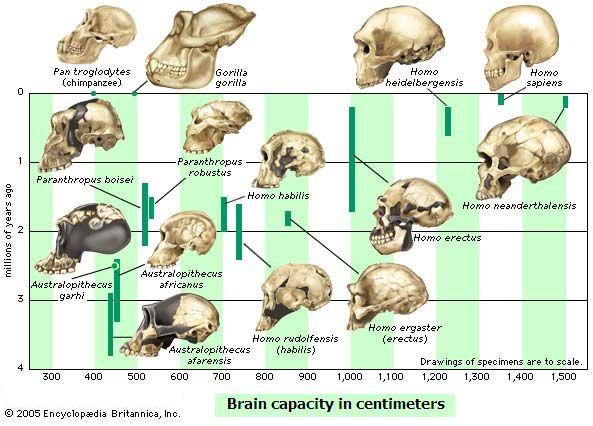
Encyclopedia Britannica Online: The increase in hominin cranial capacity over time

Yet, this is not the case when the anomalous (mutated) "species" called the "homosexual perspective" is included in the equation in terms of human survivability. If it is included, and interpreted as if it represents an advanced hominid mental state, like the cro-magnons who came to dominate their Neanderthal cousins; humanity could well cease to exist if all other values of present hominid thinking were to be extinguished because they are thought to be "equal but inferior". In terms of relating Homosexuality to its own Cosmological value system; it represents a black hole from which humanity could not escape an eventual demise if it were permitted to grow as a source of social energy drain on different resources, reasoning and rationality.
Like religion, homosexuality has its own logic that attempts to substantiate itself on the grounds of an argument imposed upon a conventional perspective by shouting louder to cover-up a distortion of thinking and yet wanting to claim it represents a superior, third way of thinking derived by some mathematically incoherent formula that arbitrarily uses Rationalism and Empiricism in one or another oppositional propositions:
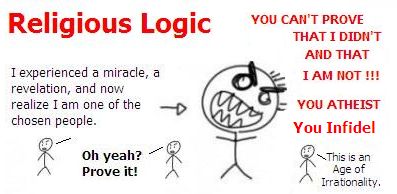 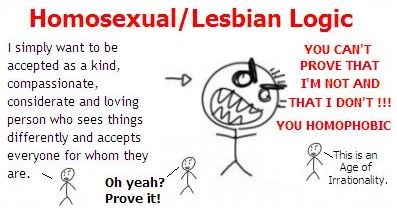 | ||
In terms of a dichotomy, the above images constitute two different types of logic which can be labeled conventional and unconventional. In terms of ego posturing, a person might want to ascribe the value of three different types of logic. In terms of mental processing, all three perspectives are of one mind, so-to-speak, in that they come from the same type of processing architecture.
And I am not talking about human brain matter, I am talking about an underlying scaffolding such as, for example, being able to distinguish and then supersede (replace) the two-patterned on/off electronic-based switching with an actual three-based signification that is not redirected into a three-patterned configuration due to an application of the And/Or/Not Boolean logic (and its supplementations).
For example, an extra-terrestrial might have a biologically-based brain, but the scaffolding in the brain by which it reasons might be markedly, or even just a little bit different then our own type of reasoning. Whereas the typical human relies on a two-patterned logic such as Rationalism and Empiricism, (or any other dichotomy you prefer); the alien-to-us entity might largely think in a pattern-of-three way. A discovery on their part that might be both amusing and disappointing since it would need to use very simplistic "show and tell" representations in an effort to communicate, with more sophisticated ideas light years away from out ability to comprehend.
Whereas we can identify numerous dichotomies as described with different labels and displayed in recorded history, we fail to acknowledge that the existence of a maturational effect would necessarily entail a sequential complexity. For the present discussion, this would be a "three" following a "two". Yet, a multiplicity of singularities is shown to have existed in the notion of many different gods which came to be combined to form the concept of a single, all-embracing God (with a capital "G"). It's like using parenthesis to group an assortment, and then using a singular term to denote the group's many qualities. It's also like humanity having reached a cognitive limit (capacity) and had to fall back on an earlier perspective in order to re-group, to catch its breath, to string all the different charms and trinkets onto a single chain of thought.
Nonetheless, from this "one" was aligned a "two" in terms of dichotomies, and then a "three" perspective began to emerge, even if the general public was not cognizant of the "three" as part of any sequence. For example, while we of today count an assort of three gods, three gorgons, a three-headed dog, etc., having existed as references in the past; this does not mean the people of the past had any acknowledged perception of the "three" as a recurrence, just as many people of today are unaware of the existence of "threes" being used in different subject areas. Like wise, just because we use the word "trinity" to describe an organization of three different gods, does not mean the people arranged or aligned them as an intentional group-of-three designated with a singular word, such as "trinity" or otherwise. Such an instance may mean we of the present are imposing our perception on a circumstance of the past which did not in fact exist.
Many of the "threes" we have today, such as having a first, middle, and last name, did not exist in the distant past. While some still have two names, and most of us are familiarly referred to by a single name or title, the usage of more than three names did not become wide-spread, and was frequently reserved for nobility whose egos were flattered by having more names because it represented some measure of wealth in terms of an over-valued reputation. The more names and titles, the greater one's believed in social distinctiveness and worth. A multiplicity of names was an outgrowth of a system that once identified people as the son of someone. Names like Samson, Johnson, Wilkinson, etc., identified particular males as being the son of someone already known. But as population increased, more names were added. Today, an increased population has produced an identification system involving numbers such as social security numbers, driver's license numbers, etc... If the population outgrows those who die, some other system might well come into being.
The point to be made with all these excursions is to point out how one system can lead to another and few are cognizant that they are participating with an exercise thereof. In terms of dichotomization, for those who do not create their own in attempting to distinguish what they believe to be that which has been overlooked, they may well engage with an attempt to portray some "three" pattern within the limitations of a previously designed dichotomy, or design what they believe to be a new dichotomy (dualism) containing an additional item which they hope to convince others is unique, but can also be substantiated because some other dominant "three" pattern already exists (such as the Trinity). They may even create a trinity out of three dichotomies. And who knows, someone may want to combine all the dichotomies into a single reference just as all the ancient gods were collected into a singular reference denoted as "God" that embodied all characteristics of believed in power and greatness.
The following triad of dualisms are explained as general categories. A "true duality" it is conjectured, is non-divisible and can be "ruled over" by a single god or entity (displayed by the "flash" occurring between the two duality components). This is ridiculous. Because if they are not divisible, then they can not be proportionately combined such as in the Yin/Yang concept which seeks harmony through proportionality. If hot and cold are not divisible than you can't have warm. To be able to proportion means divisibility.
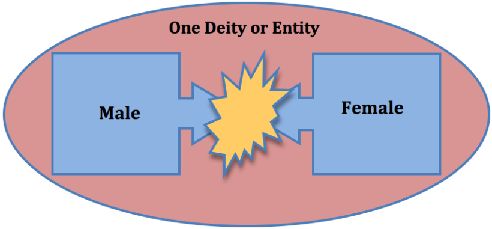
If one should claim that God is the "happy medium intercessor" which keeps two opposites apart (as a buffer against collision) and yet keeps them together, then God is the proportionality and does not exist without duality. Yet, if God is a single entity unto itself, it doesn't need dualities to exist, which includes any and all dualities conjectured by humans. The dualities inherent with human thought may be little more than an expression of socially functionalized schizophrenia (in terms of ambivalence), because humanity has trouble making up its mind due to being subjected to an environment which influences dichotomous thinking.
The idea of opposites remaining apart and yet remaining together may be little more than a human contrived representation of electro-magnetic forces on this planet which have played a part in establishing a recurrence of dualistic thinking as well as influencing biological structures which have reciprocated and assist with the establishment of such a formulaic profile. But such a two-patterned structure as dualisms (dichotomies) is not the only pattern. If we do make a claim that environmental patterns can and have laid the frame-work of certain patterns by which our physiology and psychologies (philosophies, etc.,) have gotten a pristine influence, then an overall tri-partite system of referencing provides a general rule-of-thumb in the form of Monads - Dyads - Plurality.
The heading of "plurality" would be a columnar indexing of items individually numbered as three, four, five, six, seven, eight, nine, ten, eleven, twelve, thirteen, etc., with the value "three" as the predominantly occurring plurality. It's not that the human mind can not conceive of larger values, but the environment to which we were born genetically, has imbued its patterns of "behavior" on us and requires that we mimic its patterns (circadian, etc.), as a tool of survival. In terms of survival in a changing world environment which can change artificial (cultural/social) environments created by humans, it is perhaps advantage to be a generalist which provides for a larger ability to be readily adaptable to changing circumstances than to be a specialist that may have more difficultly because of less flexibility... like old age, illness, or physical/mental incapacity. Our anatomy has like-wise followed suit, and our minds tag-along like a child following some older sibling around. Indeed, our body is much older than our present brain/mind. But it is much younger than our genetics. Hence, this is a three-stage developmental portrayal.
Interestingly, with respect to plurality and its referencing to Monads, dualities and (tripartite) syllogisms, take a look at the following excerpt about "Logical Pluralism":
|
Logical pluralism is the thesis that there is more than one correct logic. The main opposing view, logical monism, is the thesis that there is only one. In fact there are many pairs of such opposed theses—and so, many different versions of the thesis of logical pluralism—corresponding to the different ways in which one can specify more carefully what a logic is, and what it would be for one to be correct. Some of these further specifications result in versions of logical pluralism that seem relatively anodyne: if any formal system can correctly be called a ‘logic’, and to call one ‘correct’ is to say that it has a use, then it seems clear that there can be more than one correct logic given that, say, linear logic has computing applications, and Intuitionistic logic is useful in constructive mathematics. In practice, philosophical attention has been focused on pluralisms that employ stricter interpretations of ‘logic’ and ‘correct’. If a correct logic is a complete and accurate specification of the relation of logical consequence on a set of truth-bearers, and in order to count as numerically different logics must disagree about whether that relation holds between the premises and conclusion of some argument, then the thesis that there could be more than one correct one will be of considerable interest to philosophers of logic, and, indeed, to anyone interested in consequence and argument more generally. Gillian Russell (grussell@artsci.wustl.edu) Open access to the SEP (Standford Encyclopedia of Philosophy) is made possible by a world-wide funding initiative. Please Read How You Can Help Keep the Encyclopedia Free. |
For example, it is widely known that a person's brain retains an image of a limb (structure) after it is amputated. It is called the phantom limb phenomena. As such, it is not too difficult in considering that a recurring three-point articulation of a limb (shoulder, elbow, wrist... hip, knee, ankle... and let us include finger joints), have imparted a three-patterned image on our brains as well, though the loss of all three may not be seen as a phantom, they may nonetheless be reacted to as an unrecognized phantom; even those these examples are not the only three-patterned referenced structures in our bodies. Our genetics, our bodies, and our minds are like a radio receiver tuned-in to the one - two- three wave length(s) of this particular environment. But as evidenced by mutations, it would appear our genetics has an ability to adapt to changes... meaning the human species might well change its mind from being human to an alien form it is subjected to an other than Earth system with different cyclical patterns (which may include an absence, intermittancy, etc..).
Those expressions involving far larger numbers are more in-line with an expression of ego, like those who used multiple names in the past, as mentioned previously. In some instances entire cultures may have utilized large numbers for their currency or as an expression of great value to try to advance an impressiveness of stature, wealth or superiority. For example, many of us have encountered someone offering alternative ideas to a suggestion. It's not because they were trying to be helpful, they just wanted to try to express a greater number of ideas. And very often, such individuals do so only to create an obstacle to someone's idea so that either an idea of their's is used, or they simply thwart the efforts and actions of one or more others into doing something they would feel left out of because they would feel inferior if they had to assist with someone else's idea.
Also, such individuals are rarely asked to list all the alternatives they might want to come up with and used as a list to either make usage of or dismiss by those who were involved in an initial idea in the first place. In other words, if they have objections they should state them and let them be examined for fruitfulness or its usage by someone as an item of intended spoilage. Some people often hover about fresh fruit like flies waiting for a chance to land and stake a claim, and yet end up creating spoilage. If a person wants to interject one or more alternatives, let them list them and not merely fling them about like one or more hungry flies wanting to interject that which is akin to a maggot. Typically, to do more than talk extinguishes their attempt to "throw a wrench" into a system, even before it is given a chance to work. While alternatives can be seen as an act of plurality, a plurality of rotting or artificial (such as wax) apples set up as a public mantle piece for proprietary display does not mean such a plurality has to be accepted as appealing because they can be tastefully bad or tasteless.
A tripartite model involving the notion of plurality can be alternatively described in a plurality of ways, though some may prefer only one, or only two. Here are some others, though the reader may be able to attach others to this short listing:
- One - Two - Many
- Unipolar - Bi/Dipolar - Mulitpolar
- Single - Double - Triple
- Here - There - Everywhere
- Single individuals - Twins - Plural sameness (with triplets occurring most frequently.
- One Dimension - Two Dimensions - Multi-Dimensions (with three most prominent).
- etc...
And though we may list varieties of this configuration, it is a singular configuration like a set-of-three. Like primitive peoples whose words-for-numbers are denoted as One - Two - Many, in that the word "many" represents all numerical values after two, we of the present have no word beyond plurality. It has become our cognitive limit. Even if we were to enumerate it, the usage of any number value is also representative of a cognitive limit. We are unable to think beyond a numerical symbol. And like a primitive who would not be particularly troubled by our comments about numbers that exist beyond its three-part numbering system, most of us today would not troubled by a notion suggesting the existence of something beyond our numbering system, even though most have not even contemplated such a metaphysic.

The primitive expressed plurality with a word such as "Many", and we of today use a plurality of numbers to express a similar singular mindset of plurality. The word many was viewed as "infinity", though such a concept was not rendered into a realization. A primitive did not conceive of anything beyond "many", and most of us today do not conceive of anything beyond our numerousity. Whereas someone might want to substitute numbers with other symbols, the same underlying basic "Many"/plurality is referenced. And yet, with this writing, many more are now aware of our present cognitive limitation in this respect, and may strive to think beyond it... though someone may have knowingly or unknowingly already achieved this.
All of our human philosophies, religions, sociologies, histories, government structures, psychologies, etc., involve a single, double or plural design, with the plurality most often exhibiting a pattern-of-three. Beyond the three usually involves a multiplicity of the first three... and is not actually necessary because the environment "speaks" to us in the simplest of terms with respect to requiring certain patterns to which we must adapt in accordance with. And we might even want to express the comment that all our symbolic systems can be looked upon as a single representation of plurality, which includes all our technologies, all our knowledge. What then of a mind that can assimilate and collate all of it into a coherent amalgamation?
Such an amalgamation does not necessarily mean an ability to utilize all the individual information as might a presumed expert or genius. An amalgamation may mean something altogether different in terms of an evolutionary changed brain-mind. For example, while someone in the distant past may have been an expert at identifying what plants could be used for some ailment and be viewed as an expert thereof, such a knowledge when juxtaposed with the different knowledge types used today, might be viewed as negligible. Likewise, in context, many different types of knowledge might be said to be useful and have representative experts and geniuses, but in relation to a system of knowledge relevant to an evolved brain-mind, all of them might be negligible. Viability in terms of a future in the making, may make it advantageous for people to be generalists in terms of being a jack or jill of many knowledge "trades" (systems) which would make them a pluralist in terms of knowledge systems, though they might will be singular in terms of being monogamous, and a dualist in terms of considering alternate perspectives.
Our bodies and minds may be little more than different types of carnival mirrors giving distorted reflections of underlying environmental circumstances, though there is an inherent capacity to stop acting like clowns (that are seriously) amused with our antics... some of which are claimed to be superior (distortions) to all others... many of which take on formal memberships and require step-wise forms of recognition for abilities which achieve a functional similarity by way of mimicry! We call such memberships by different names involving hierarchical structures for a given setting... all of which are actions of monkeys vying for different positions on various socialized trees.
For example, education systems are set up for individuals to acquire knowledge in a singularly systematic way and arrive at similar conclusions. And an individual will arrive at similar conclusions because of how and what types of information are provided within a context the individual must adapt to. This is similar to those receiving instruction in any singularly given subject, be it religion, biology, mathematics, mechanics, horse riding, swimming, card playing, etc... But such individual studies are not for those whose minds see things more comprehensively and can not only assimilate but collate large amounts of diverse information. Most individualized subjects are for those who must focus their energies and efforts on a single topic, and place all other experiences in relation to the singular context.
But it must be remembered that an education system may be a money making enterprise for some investors. So long as the system in which their subjects are applied is maintained, they can stay in business. Likewise with religions, charities and governments, with different entities within attempting to make themselves appear useful... even if it means instigating circumstances to give the impression of being needed. Society will not improve beyond its present course unless such systems are radically altered. Each of them is fighting for a share of the available loot, whatever it is called and however it is valued within a given context.
Like fighting over a bunch of bananas in various stages of ripening, so much of human social behavior is guided by trying to get a portion of one, or two with which to share with a select other, or acquire more than most. Whereas some are inclined to be single-minded, others are dual-minded, and a few are triple-minded, with many using the third form in various pluralistic models. And though some see the "two" in terms of dualisms and may even note various two-patterned ideas (positive/negative, right/wrong, good/bad, etc.), and a few recognizing environmental events which can influence such thinking, they don't see dichotomies as part of an overall three-pattern (single - double - plurality) formula.
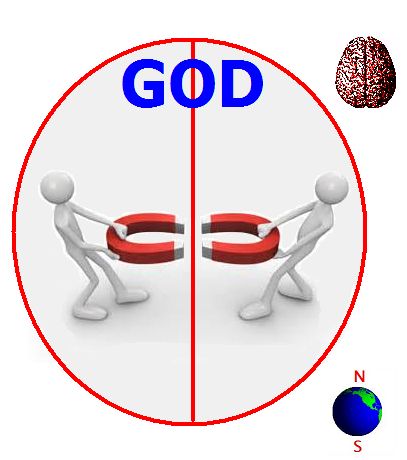
While the concept of "GOD" was placed in the frontal lobe position, I am not convinced it should be here though this is where many humans place it in terms of suggestive prominence in their life and the life of humanity and the Universe. Nonetheless, no matter what position I placed it in, someone would want to interpret it in a theological way. For example, If I had placed it to the rear of the brain outline, someone might well have interpreted this to suggest a dominant vision. If I had situated it at the base of the brain in the reptilian position, someone might have interpreted this as a "source" representation... and so on and so forth.
The mental activities of dichotomization may well persist so long as humanity remains in an environment dominated by circumstances of polarization. And as a result, philosophies, psychologies, sociologies, politics, religions and biology may be able to do little else but adapt to these effects. This in no way implies that dichotomization is universally dominant, it only means it is a rule-of-thumb while humanity remains subjected to present circumstances on this planet, in this solar system and perhaps in this galaxy. Elaborate philosophical doctrines involving perspectives of dualisms and dichotomies are adaptations to former adaptations. Compilations can give the impression of complexity, but the basic formula is still a response to environmental influences. The God that humans know of is the God of this world's influences on our biology. Judaism, Christianity and Islam were all born in desert terrains. And yet, so very few have contemplated the origin of their religion as being little more than an accumulation of responses to a specific terrain. The God of humanity may well be quite different in the deep recesses of space, when humanity is far removed from all the present day nonsense.
By removing the theological dogma as being that which "rules over" dualities, we might instead want to use the words such as guiding principle, universal law, force limitation, containment field, the (combined) inverse property of attraction and repulsion, (mathematical) inverse function, etc. Take a look at a wordweb dictionary listing of an inverse function in mathematics, and relate it to the present discussion of dualities:
A function obtained by expressing the dependent variable of one function as the independent variable of another; f and g are inverse functions if f(x) = y and g(y )= x
It is difficult for me to fathom why a concept has to be "ruled over" by an entity or god that is then turned into being the Crux of some world-view rationalization called religion. Such is philosophical nonsense which is an admission of irrationality. One would think that humanity could go beyond such primitivization of thought. Theism and Anti-theism (Atheist) as well as Christ and Anti-Christ are just more of the same exercise of mental dichotomization taking place in this Age of Irrationality. It is incredulous to view people discussing a ONE God, TWO-part schemas, and utilize overall THREE-part formulas such as the Trinity, and yet remain oblivious of the ONE - TWO - THREE pattern in their thinking; that is then NOT related to the patterns in other subject areas. Yet, if they do, they see only a theological connection to some ridiculous notion of a Trinity that is little more than a reflection of an environmental event; that is changing and will thus effect their thinking in a similar manner!!!
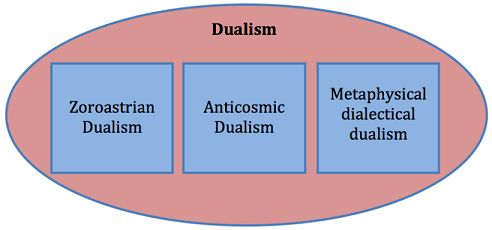
Here's a small portion of the accompanying information from Defining Dualism (the dualism of John's gospel part 2):
Zoroastrian dualism features a belief in one God, Ahura Mazda, who created all that is asha, truth and order. Druj, chaos or falsehood, does not originate from Ahura Mazda and the conflict between asha and druj is one that involves the entire universe and all of humanity.
Anti-cosmic dualism, as in Gnosticism, sees the conflict as one between the material world of matter, which was seen as evil, and the immaterial, which is seen as good. Salvation for the soul within this model could be obtained through gnosis, that is, special knowledge, which would allow the soul to escape the material and be free from matter.
Metaphysical dialectical dualism such as in Plato’s philosophy of the Form and Matter, holds the universe is made up of two separate principles that are in tension with one another yet both necessary for the universe's continued existence. As we mentioned previously, the Yin and Yang are an example of this, where both the Yin and Yang are in tension with one another but the universe is upheld by their balance, not the overtaking of one by the other.
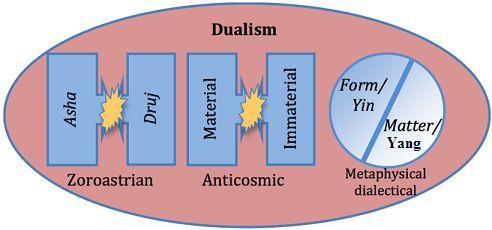
Despite the sincerity of the writer's perspective, we can not be certain that dualisms (or dichotomies) have anything to do with the universe, when the "universe" is defined in reference to perspectives which may one day be developed elsewhere than on Earth. Nonetheless, as stated from a general perspective, three overall types of dualisms are portrayed as taken from this source Ugo Bianchi, The History of Religions, (Lieden, Neatherlands: Brill Archive, 1975) 42.:
While some might want to make a similar comment about threes, my intent is not to create a war between those who favor dualisms and those favoring some other pattern(s), but to enhance the awareness of a mentality that is not only as primitive as some rodent's, but we are in a better position than the rodent to exceed this mentality. We're presently like a bunch of kids sitting around a table picking and choosing what colors we want to color a page with two circles on it. Some kids want to use one color, some two colors, and others perhaps three or more. Some of the kids prefer to sit coloring on the floor, others want to sit on the floor but color the page on a chair, and others want to hold the page to a wall to color it. And some even refuse to participate because they think coloring is stupid. But instead of crayons, paints, colored pencils or marker, we use words.
Yet, along comes a child who acts very strange indeed... at least to other kids expecting them to do as they themselves are doing. They don't articulate what they are perceiving, and can't quite grasp what it is; but it's a perception of the total situation which will come to signify later perceptions that they may or may not eventually find the vocabulary to articulate their perceptions that were born on the day they saw something different... and yet may have momentarily shrugged it off thinking it was a perception others had as well.
For the sake of argument, let us say that a "three" focus is little more than an emergent property of a two-patterned perspective. This would explain why many people re-organize dichotomies to represent some fashion of a pattern-of-three.
It terms of distinguishing differences in reasoning amongst humans, say for example between Einstein and a "normal" person, we might readily agree that he reasoned differently, in some respects, though he had a similar brain... at least we might want to assume. But, Einstein expressed his different way of thinking in terms which produced ideas that were shared... even though it took awhile before others turned away from their own cave shadow viewings to see the outlines of the drawings he made.
The reason for saying this is to establish the perspective that there may be many different types of thinking existing in the world today, but those harboring such unrecognized differences may not even be attempting to exhibit them (not even mischievously so), in a mode and manner which can be recognized as being significantly different from the "make-a-buck" commercialized variety. And I am not talking about the creation of different songs, different clothing patterns or different recipes when fixing a meal. I am talking about that which is disproportionate to conventions of thinking that is an actual realization that can be fortuitously applied and does not remain as a supposition, computer generated graphic, or illusory condiment for one's steak and potato brand of intellectual meals. Such disproportions may occur thousands of times on a daily basis, but they are not widely made known.
HTML (4.01) update: Monday, June 10, 2019... 7:18 AM
Your Questions, Comments or Additional Information are welcomed:
Herb O. Buckland
herbobuckland@hotmail.com